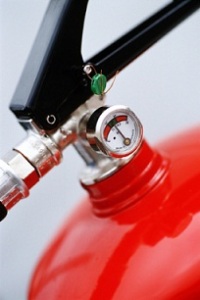 In the following paragraphs I’d like to introduce the subject of maintaining your extinguishers and the reasons why it’s extremely important.
In the following paragraphs I’d like to introduce the subject of maintaining your extinguishers and the reasons why it’s extremely important.
I’ll also go into much more depth and introduce a few other issues you should look into when it is time for you to service your own extinguishers.
Along with this I’ll look at the proper BSI standards and why should you be familiar with them.
Maintenance isn’t something you ought to go cheap with. Preferably you will not need to use your extinguishers but if/when you need to do, you want to ensure they are safe and available immediately.
Relevant BSI Codes of Practice
Even before you think about selecting someone to carry out your extinguisher servicing, it’s best to ensure they operate in accordance with British Standard Code of Practice 5306 Part 3 – 09.
BS 5306 is the combination of BSIs British Standards related to fire extinguishing setups and equipment. Section 3 is the Code of Practice for any commissioning and maintenance of handheld fire extinguishers.
As most individuals use transportable units, this is actually the part which is likely to be the most relevant for your fire extinguisher servicing needs.
Assessments Made Throughout Maintenance
Choosing an individual who works within the BSI Code of Practice helps you to satisfy the health and safety guidelines inside your work environment.
Additionally, it is great to learn a little bit regarding what type of work ought to be performed on your own units.
Almost all fire extinguisher variations needs to be inspected for pressure, mass and also for any obvious indication of problems, which includes dings or corrosion.
Just about all elements, pipes and hoses should be checked to ensure they function correctly and labels really should be checked to make sure that they’re still quickly legible. Cartridge based units may also be examined internally by opening them up, but don’t try this by yourself.
If the suggestions above are checked at least once yearly your servicing should have done it’s job. You’re going to be safe in the knowledge that if you ever need to use your extinguishers they’ll be available as well as in good working order.
Other Associated Things to Consider
Something that’s easily overlooked is that water and foam type units which are not inside a warmed atmosphere throughout the winter can freeze.
These types of models should contain a low temperature chemical to stop them from freezing up.
Carbon dioxide extinguishers have to have conventional servicing for a decade. From then on a hydro-static test should then be caried out.
Following this time period though it’s usually a good plan to change the extinguisher for a brand new one. As the units get older there comes a point where it’s more safe and economical to change them.
Remember that your old fire extinguishers usually can be recycled too.
Consult your regional authority or your fire extinguisher servicing supplier for details about recycling your old units.
If you want fire extinguisher servicing, refilling, products or just more free advice, please see: Fire Extinguisher Servicing
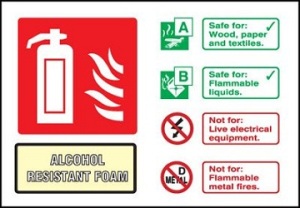 Foam based extinguishers should be employed on fuel fires in either an aspirated or not aspirated type. Aspirated foam extinguishers are merged and expanded with air within a branch pipe.
Foam based extinguishers should be employed on fuel fires in either an aspirated or not aspirated type. Aspirated foam extinguishers are merged and expanded with air within a branch pipe.
Non aspirated foam deposits itself to develop a frothy sheet or seal above the fuel. This keeps oxygen from reaching it. Compared with powder extinguishers, foam can be used to put out fires but without the chance of flashback.
Here’s a description of some of the most typical varieties of foam fire extinguisher:
Aqueous Film Forming Foam Units
AFFF foam units are mainly suited to Class A as well as B fires as well as vapour suppression. This particular foam is commonly used in lightweight foam extinguishers.
The bad side of this sort of foam is that it features fluoro tensides which unfortunately can be accumulated in the body.
The long run side-effects with this on people and environment are not wholly understood.
Alcohol-Resistant Aqueous Film Forming Foam Extinguishers
AR-AFFF extinguishers should be utilized on fuel fires containing alcohol.
This kind of foam extinguisher develops a membrane in between the fuel and also the foam. This stops the alcohol from breaking down the foam cover, as would be the case with other sorts of foam units.
Film Forming Fluoroprotein Foam Units
FFFP extinguishers contain natural animal proteins.
Additionally, they include man made film making agents to create a foam cover which can be more heat resistant in comparison to the AFFF foams, which are entirely synthetic.
Very much like AR-AFFF foam extinguishers, FFFP can be quite beneficial on alcohol based liquids. That’s the reason these are popular in motor racing and can often be noticed around the pits as well as at the marshalling locations.
Compressed Air Foam Units
These are typically similar to air pressurized water but they will use foam as the extinguishing agent as an alternative to water. They are mostly utilized to extend a water supply in wild land strategies.
They usually are suited to class A fires and with exceptionally dry foam also on class B fires, where fume suppression is important.
Less Common Foam Variations
A less common foam type is Arctic Fire, used a good deal in the sheet metal business because of it’s superb cooling qualities. You can also find the FireAde foaming agent which emulsifies burning fluids and means they are non-flammable. It ought to be observed that this type of foam still contains water so can react with certain metal fires.
Foam extinguishers are rather flexible and as you will notice from the above, they come in numerous types for usage in different purposes.
If you’re looking for fire extinguisher servicing, recharging, products or maybe just more free facts, take a look at: Foam Extinguishers
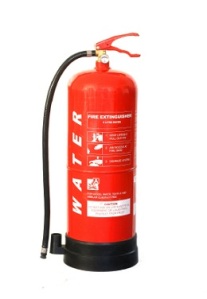 The popular and well recognized water fire extinguisher is a common occurrance nowadays for a number of good reasons.
The popular and well recognized water fire extinguisher is a common occurrance nowadays for a number of good reasons.
There are a couple of different kinds of water fire extinguisher , nevertheless they all extinguish fires by taking off the same part of the fire triangle, heat.
The higher than average specific heat capacity for water causes it to be an excellent agent for taking away or shifting warmth.
That’s the reason why it can be utilized in many cooling and heating systems, in organizations, machines, homes and vehicles.
This kind of characteristic also causes it to be good for eradicating heat originating from a fire as a way to extinguish it speedily.
Air Pressurised Water Fire Extinguishers
As the name implies, air pressurized water (APW) extinguishers make use of pressurized air to eject the extinguishing agent (water in this instance) towards the fire.
APW units are relatively economical and after a fire is extinguished water is relatively simple clean up.
Usually the vast majority of the water has possibly dried up already making the cleanup effort a whole lot easier.
Water units are often colored solid red as this is the colour code used for water.
Water Mist Units
A further variation on the water fire extinguisher uses a fine spray rather than a jet of water.
They’ll use a fine misting nozzle to help break-up the stream of water so that it’s no longer capable of conducting electricity back to the operator.
The de-ionized water is really safe and doesn’t ruin it’s area. This makes it appropriate for use in hospital wards.
This kind of water fire extinguisher is also painted red in the European Union however in the USA they are frequently white.
Additives Utilized in Water Fire Extinguishers
Wetting agents tend to be found in water extinguishers. Most are detergent based and are helpful to break down the surface tension of the water.
It will aid water to go into the organic material (paper, timber or cloth for example) that is on fire.
Antifreeze is generally combined with the water. This is useful if you use water based units in particularly cold conditions.
This will lessen the freezing point of the water to enable it to be efficient for a longer time in frigid environments.
Using the antifreeze won’t have noticeable negative effects on the extinguishing capabilities either.
Water based units are most effective on Class A fires.
We need to remember that water units of any version should not be applied to live electric powered devices as this can be quite high-risk.
If you are seeking fire extinguisher servicing, refilling, accessories or perhaps more free information, go to: Water Fire Extinguishers
Frequent servicing of one’s fire extinguishers is a legal dutie in a great many parts of the modern world therefore you need to ensure you satisfy any local fire protection regulations.
In the States fire extinguishers in any structures (except for residences) are actually needed to be maintained and assessed using a fire protection service company at least once each year.
Nonetheless, specifics of legal obligations do vary from state to state so you should keep this in mind.
In England and Wales the Regulatory Reform (Fire Safety) Order of ’05 is applicable. It came into force on 1 October 2006. The Fire Safety Order addresses nearly all factories and nearly every style of building, structure and wide open space.
After the fire extinguisher maintenance a fire label will likely be affixed to the fire extinguisher which will signify the type of service performed and also the date it was carried out. The leading kinds of servicing include annual check up, refilling and complete replacement.
Maturing Fire Extinguishers
Even in the event that a fire extinguisher isn’t used it doesn’t suggest it is going to last for a lifetime. As they age they could drop pressure, corrode or seals might decline under the amount of pressure.
Although extinguishers may be refurbished it’s actually not a rapid and simple operation. Some people find it easier to simply switch their older fire extinguishers for new ones. The good news is your unwanted fire extinguishers can be recycled.
Always ensure that you dispose of any old fire extinguishers responsibly. Your neighborhood council are able to help with small quantities, otherwise you ought to call special companies.
Don’t forget, fire extinguishers are generally under significant pressure and can be dangerous if not discarded or serviced in the appropriate manor.
Fire Extinguishers and Vandals
Fire extinguishers are quite often an easy target of vandalism, that is certainly one other reason for regular fire extinguisher servicing. This sort of vandalism is especially prevalent in schools and colleges but could occur almost anywhere.
Extinguishers may just be partially or fully discharged by vandals. This tends to lower the capability to fight fires or worse still, prevent it altogether. After such an event you’ll at the least be looking to purchase a fire extinguisher refill.
In areas where they’re particularly exposed extinguishers really should be kept inside cabinets which are protected by glass which must be broken to get entry. Other units will sound an alarm which may only be silenced by using a key.
Perhaps you have realized there are many reasons why regular fire extinguisher servicing is important, the most significant being that lives may be on the line if it isn’t done properly.
If you want fire extinguisher servicing, refilling, products or perhaps more free information, check out: Fire Extinguisher Servicing
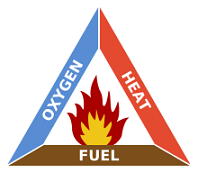 The fire triangle can be described as a method of imagining the three parts required to generate and perpetuate a fire. The fire triangle is sometimes called the combustible triangle however they are the same.
The fire triangle can be described as a method of imagining the three parts required to generate and perpetuate a fire. The fire triangle is sometimes called the combustible triangle however they are the same.
The parts of the fire triangle are as follows: Heat, Fuel plus Oxygen.
All of these components need for a fire to be present, so to prevent or put out a current fire we simply need to remove at least one of the elements.
The various fire extinguisher forms are supposed to take away one or more of the parts as a way to put out a fire.
By way of example, water eliminates heat and foam can stop oxygen from getting to a fire by coating it like a sheet. To eradicate the fuel source is a little more troublesome.
The Heat Part Within the Fire Triangle
Lacking heat a fire can not be generated plus it can not carry on and burn. As mentioned earlier the most effective way of eliminating heat is using water.
We might also eliminate heat (the ignition origin) in an electrical fire by switching off the electric power.
In any burning structure the hot embers in many cases are scraped away from the fire, yet again removing one of the heat sources and making the fire much easier to extinguish.
The Fuel Part Within the Fire Triangle
Without having fuel a fire can’t carry on and burn. Gradually a fire will burn itself out with time as the available fuel is used up.
However, with regards to a fire we should extinguish it as rapidly as is practical to minimise any damage so if the fuel can safely be removed it ought to be.
The fuel can be removed physically, which may be harmful to execute or it could be eradicated chemically using the correct fire extinguisher type.
Doing away with localized fuel sources may also stop the fire growing or keep brand new fires from starting up.
The Oxygen Component in the Fire Triangle
Lacking oxygen a fire can not be created or carry on and burn. Oxygen can be kept from reaching a fire by employing something like a foam fire extinguisher and even a fire blanket in many conditions.
A fire won’t often burn itself out due to a scarcity of oxygen like it is going to if it has no fuel. There is often a plentiful availability of oxygen to help keep a fire going indefinitely.
Fire Tetrahedron
A fire tetrahedron is a variant of the fire triangle. It presents the requirement for the chemical reaction that is the process which generates and sustains a fire.
Halon fire extinguishers enable you to decrease this final part because they reduce the chemical reaction.
If you’d like further information, please take a look here: Fire Triangle and Fire Tetrahedron
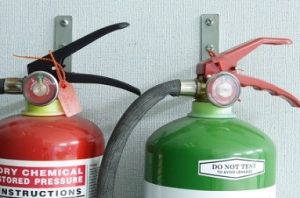 There are numerous kinds of different fire extinguisher types which you must be conscious of. The kind of the extinguisher not just has a bearing on the way it must be used, it influences how it’s maintained too.
There are numerous kinds of different fire extinguisher types which you must be conscious of. The kind of the extinguisher not just has a bearing on the way it must be used, it influences how it’s maintained too.
Fire extinguishers implement various ways to eject the extinguishing solution through the extinguisher to the fire.
Furthermore, they use different kinds of extinguishing solution that are employed to extinguish different fire classes.
To help make the identification of fire extinguisher types easier, they’re colour coded in line with the sort of agent they use and hence the categories of fires they should be used against.
To make sure you utilize the proper fire extinguishers to do the job and also to ensure you service them effectively you should know a bit with regards to the differing kinds to choose from.
Styles of Fire Extinguisher Appliance
There are 2 major sorts of fire extinguisher, stored pressure and capsule powered.
In stored pressure appliances, the expellant is kept in exactly the same holding chamber as the extinguishing solution. Stored pressure fire extinguishers are the most commonly encountered fire extinguisher type.
Many propellants are used depending upon the extinguishing agent. With dry chemical type extinguishers nitrogen is sometimes made use of. Standard water and foam extinguishers almost always use air.
When it comes to cartridge controlled extinguishers the expellant gas is held in an individual cartridge.
Cartridge powered extinguishers are usually not as common as the stored pressure form. They’re used in regions which includes industrial facilities, where they will end up with more regular use.
They’ve got major benefit of easy and fast charging. This enables a user to employ the extinguisher, recharge it and then come back to the fire with minimal holdup.
Styles of Fire Extinguisher Agent
Powder – powder based units extinguish fires by separating the various components of the fire triangle. Doing this prevents the chemical reaction between heat, fuel and oxygen, thus extinguishing the fire.
Foam – foam based agents are used to put out fuel fires by creating a foamy sheet above the fuel, stopping oxygen reaching it. Unlike powder, foam can be used to extinguish fires without any risk of flashback.
Water – air pressurised water extinguishers cool combusting substances by absorbing heat away from it. Water offers the advantage of being economical, safe, and simple enough to clean up.
Fire Extinguisher Mobility
Together with each of the fire extinguisher varieties described earlier, they’re additionally split up into hand-held and wheeled extinguishers.
The hand-held products are usually more prevalent. Even so, the wheeled units are commonly found at construction sites and airport runways and even marinas and docks.
Obviously there’s a good number of completely different fire extinguisher styles and plenty to keep in mind when choosing and servicing them.
If you’re looking for fire extinguisher servicing, refilling, products or perhaps more free advice, take a look at: Fire Extinguisher Types
 After a fire extinguisher has become discharged, either partially or wholly you may require yourself a fire extinguisher refill.
After a fire extinguisher has become discharged, either partially or wholly you may require yourself a fire extinguisher refill.
You need a refill once the extinguisher has been used to fight a fire or it could possibly have been discharged resulting from misuse/vandalism.
A test discharge may also be vital sometimes to make sure that a unit is working. This might be required if the service label is missing or maybe you are not familiar with the historical past of your extinguisher.
In most of the above scenarios you’ll require a fire extinguisher refill, to be completed by an experienced professional.
Re-filling Your Extinguisher Safely
Like most things associated with fire extinguishers the key factor is safety. With fire extinguishers refills this is particularly important as the unit might not operate correctly when required if it wasn’t refilled properly.
Apart from the unit not performing correctly there are actually serious safety issues to consider when refilling the extinguisher.
On no account should you attempt a fire extinguisher refill yourself. You could think this is obvious but people do try and undertake it themselves and it’s dangerous.
Individuals have been killed while attempting to refill fire extinguishers theirselves. The reason being, that almost all fire extinguishers are constantly under high pressure and in many cases loosening the cap may cause it to pop off at high speed.
Fire Extinguisher Refill Types
Many modern fire extinguishers will be the stored pressure type and also have a pressure gauge. These are generally cheaper to refill versus the cartridge operated units.
When the fire extinguisher is cartridge powered and it’s also ageing or it’s in a less than brand-new condition you should consider replacing it. A new cartridge as well as a refill can prove to be pricey.
Replacing old cartridge operated extinguishers will not often be cheaper than refilling even so it still might be the ideal option if for only a bit more expense you could buy a new extinguisher.
If you believe a fire extinguisher may have been misused, vandalised or used to fight a fire then it is always a good idea to get it serviced. It’s likely that a refill will be part of the work needed to bring it to a useful and safe state.
It’s important to emphasise though that you should seek professional advice and call a local fire protection experts to replenish your extinguishers for you.
Unless of course you are a certified fire safety specialist yourself you shouldn’t be attempting any kind of fire extinguisher refill.
If you’re searching for fire extinguisher servicing, refilling, products or possibly more free advice, please see: Fire Extinguisher Refill
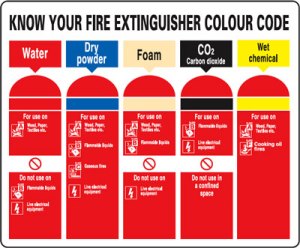 Different fire extinguisher colour codes are used between Europe, Australia and America. You’ll also find varieties within each geographical location. For instance some of the older extinguishers use different colour codes.
Different fire extinguisher colour codes are used between Europe, Australia and America. You’ll also find varieties within each geographical location. For instance some of the older extinguishers use different colour codes.
Colour coding improved in 1997 for Europe as a consequence of the introduction of BS EN 3. Before BS EN 3 solid colours were utilised, but BS EN 3 announced coloured bands instead.
In Australia yellow halon fire extinguishers are against the law to acquire or use. An exception to this is when an essential use exemption is granted.
There is not any official standard in the States for fire extinguisher colours.
Nevertheless, they traditionally use colour coded geometric designs and pictograms depicting the sorts of fires that the extinguisher is eligible to deal with.
Given all the variants in fire extinguisher colours, what follows is easily the most common convention for today’s fire extinguisher colours/pictograms in each geographical area.
Fire Extinguisher Colours in Europe
- Water – solid red
- Foam – red along with a cream panel
- Dry powder – red along with a blue panel
- Co2 – red along with a black panel
- Wet chemical – red along with a yellow panel
- Class D powder – red along with a blue panel
- Halon – (no longer utilised)
Fire Extinguisher Colours in Australia
- Water – solid red
- Foam – red along with a blue band
- Dry powder – red along with a white band
- Co2 – red with a black band
- Vaporising liquid – red along with a yellow band
- Halon – (no longer made)
- Wet chemical – red with an oatmeal band
Fire Extinguisher Colours in America
Geometric Icons
- Ordinary solid combustibles – green triangle
- Combustible liquids and gasses – red square
- Energised electrical devices – blue circle
- Combustible metals – yellow star
- Cooking fats and oils – black hexagon
Pictograms
- Ordinary solid combustibles – waste can and wood heap burning
- Combustible liquids and gasses – fuel container and burning puddle
- Energised electrical gear – electricity plug and burning electric outlet
- Flammable metals – burning gear and bearing
- Cooking fats and oils – pan burning
In picking the most suitable fire extinguisher for any given scenario the colour coding was designed to make the various types of extinguisher easy to identify.
It’s a shame that there isn’t an international standard for extinguisher colour coding but like the majority of things, it’s difficult to keep consistency across the world. This is mainly due to historical reasons.
Even so, the colour coding shown above is a great guide and there are similarities between the different countries and continents so that it is easier to learn them.
For more information feel free to visit: Fire Extinguisher Colours
 If we talk about fire classes we aren’t referring to fire study courses, we mean something very different.
If we talk about fire classes we aren’t referring to fire study courses, we mean something very different.
Fire classes are the various categories of fires that might occur, usually based on the sort of material that’s actually on fire.
The key reason why we have different categories of fire is really because various kinds of extinguisher are used to fight different varieties of fire.
It’s very simple identify the most suitable extinguisher for each fire type because they are colour coded.
Europe, America and Australia/Asia all use different classes but you’ll find so many similarities between them.
Here’s a review of all the classes employed in different countries and continents.
Fire Classes in the United Kingdom and Europe
- A – ordinary combustibles
- B – flammable or flammable liquids
- C – flammable gasses
- D – combustible metals
- E – (this class has stopped being employed in Europe)
- F – cooking oils and fats
Fire Classes in Australia and Asia
- A – everyday combustibles
- B – combustible or combustible liquids
- C – combustible gasses
- D – combustible metals
- E – electrical equipment
- F – cooking fats and oils
Fire Classes in the U.S.A.
- A – regular combustibles
- B – flammable liquids and gasses
- C – electrical appliances
- D – combustible metals
- K – cooking oils and fats
Class E has stopped being found in the United Kingdom and Europe. For the reason that if the power source is powered down (simply because it needs to be in the case of a fire) an electrical fire falls into a number of of the other classes.
Some Good Examples
Ordinary Combustibles – the most widespread form of fire caused when natural and organic solids such as wood, paper or cloth ignite. It’s ok to make usage of water extinguishers for this sort of fire.
Flammable Gasses or Liquids – that is any fire where liquid or gas fuels ignite. These have to be extinguished using dry chemical or halon extinguishers
Flammable Metals – metals for instance titanium, magnesium and uranium are flammable. Dry powder extinguishers should be utilized to fight such fires
Electrical Appliances – this encompasses any appliance which could potentially be electrically energised. Water, foam and also other agents that can conduct electrical current really should not be used to fight electrical fires.
Cooking Oils and Fats – common in domestic kitchens, saponification (a process that creates soap from fats) or fire blankets are often used to extinguish these fires. Water extinguishers should never be employed on fat or oil fires.
For more information please visit: Fire Classes
